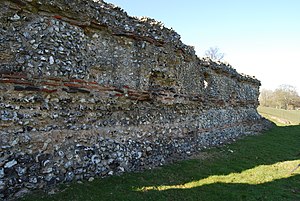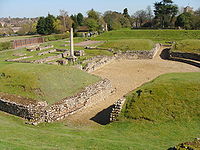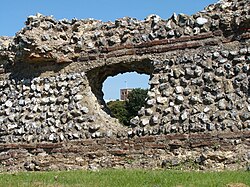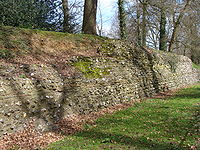Verulamium: Difference between revisions
Created page with "right|thumb|300px|Roman walls of Verulamium {{county|Hertfordshire}} '''Verulamium''' was an ancient town in Roman Britain. It was sited in the ..." |
|||
| Line 57: | Line 57: | ||
[[Category:English Heritage sites in Hertfordshire]] | [[Category:English Heritage sites in Hertfordshire]] | ||
{{Roman town}} | |||
Revision as of 20:10, 5 March 2023

Verulamium was an ancient town in Roman Britain. It was sited in the southwest of the modern city of St Albans in Hertfordshire, in an area long known as 'Verulam' and its city wall remains visible; it forms a long ridge in the park with its masonry exposed for a great length. Other remains have been excavated. Its less direct visible legacy is the tower of St Albans Cathedral, which is apparently built of Roman brick savaged from the ruins of the city.
This was an important city in Roman times. The ancient Watling Street, a major Roman road, passed through the city.
A large portion of the Roman city remains unexcavated, being now park and agricultural land, though much has been built upon.[1]
Much of the site and its environs is now classed as a scheduled ancient monument.[2]
- Maps:
- Streetmap: TL136070
- Wikishire map: 51°45’0"N, 0°21’14"W
History
Before the Romans, there existed a settlement of the Catuvellauni tribe, which in modern times is usually called Verlamion. The origin of the name is uncertain but the name has been reconstructed as *Uerulāmion, which would have a meaning like "[the tribe or settlement] of the broad hand" (Uerulāmos) in British.[3] In this pre-Roman form, it was among the first places in Britain recorded by name. The settlement was established by Tasciovanus, who minted coins there.
The Roman settlement was granted the rank of municipium around AD 50, meaning its citizens had what were known as "Latin Rights", a lesser citizenship status than a colonia possessed. It grew to a significant town, and as such received the attentions of Boudica of the Iceni in 61, when Verulamium was sacked and burnt on her orders: a black ash layer has been recorded by archaeologists, thus confirming the Roman written record.
After the rebellion was ended, Verulamium rose from the ashes and grew steadily: by the early 3rd century it covered an area of about 125 acres, behind a deep ditch and wall.

Verulamium contained a forum basilica and a theatre, much of which were damaged during two fires, one in 155 and the other around 250. One of the few extant Roman inscriptions in Britain is found on the remnants of the forum (see Verulamium Forum inscription). The town was rebuilt in stone rather than timber at least twice over the next 150 years.
The first British martyr saint, St Alban, was martyred here; he was according to his legend a Roman patrician converted by a priest, sentenced to death in the city and executed on the hill across the river, which is the centre of today's town, St Albans. The story is recounted by Gildas writing in the early sixth century, and later by Bede.
Occupation by the Romans ended at some soon time after 400: after that, the written record of the city ends and its last age can be traced only in the archaeological record.
There are a few remains of the Roman city visible, such as parts of the city walls, a hypocaust still in situ under a mosaic floor, and the theatre, which is on land belonging to the Earl of Verulam – as well as items in the Verulamium Museum. More remains under the nearby agricultural land which have never been excavated were for a while seriously threatened by deep ploughing.
Sub-Roman times

The abbey and the associated Anglo-Saxon settlement were founded outside the Roman city. The abbey is near the site of a Roman cemetery, which, as normal in Roman times, was outside the city walls. It is unknown whether there are Roman remains under the mediæval abbey. An archaeological excavation in 1978, directed by Martin Biddle, failed to find Roman remains on the site of the mediæval chapter house.[4]
David Nash Ford identifies the community as the Cair Mincip which Nenniuslists among the 28 cities of Britain in his History of the Britons.[5] As late as the eighth century the Saxon inhabitants of St Albans nearby were aware of their ancient neighbour, which they knew alternatively as Werulamacæstir or Wætlingaceaster or Wæclingaceaster.[6]
Loss and recovery
The city was quarried for building material for the construction of mediæval St Albans; indeed, much of the Norman abbey was constructed from the remains of the Roman city, with Roman brick and stone visible. The modern city takes its name from St Alban, either a citizen of Verulamium or a Roman soldier, who was condemned to death in the 3rd century for sheltering a Christian. Alban was converted by him to Christianity, and by virtue of his death Alban became the first British Christian martyr.
Since much of the modern city and its environs is built over Roman remains, it is still not uncommon to unearth Roman artefacts several miles away. A complete tile kiln was found in Park Street some six miles from Verulamium in the 1970s, and there is a Roman mausoleum near Rothamsted Park five miles away.
Within the walls of ancient Verulamium, the Elizabethan philosopher, essayist and statesman Sir Francis Bacon built a "refined small house" that was thoroughly described by the 17th century diarist John Aubrey. No trace of it is left, but Aubrey noted "At Verulam is to be seen, in some few places, some remains of the wall of this Citie".
Moreover, when Bacon was created a Baron in 1618, he took the style of Baron Verulam after Verulamium. The peerage became extinct after he died without heirs in 1626.

Verulamium Museum
The Verulamium Museum is a sizeable museum run by the local council in Verulamium Park (adjacent to St Michael's Church), which contains much information about the town, both as a Roman and Iron Age settlement, plus Roman history in general. The museum was established following the excavations carried out by Mortimer Wheeler and his wife Tessa Wheeler during the 1930s. It is noted for the large and colourful mosaics, and many other artefacts such as pottery, jewellery, tools and coins from the Roman period. Many were found in formal excavations but some, particularly a coffin still containing a male skeleton, were unearthed nearby during building work. It is considered one of the best museums of Roman history in the country and has won an architectural award for its striking domed entrance.
Outside links
| ("Wikimedia Commons" has material about Verulamium) |
References
- ↑ Boundary of settlement walls , Pleiades
- ↑ National Heritage List 1003515: Verulamium
- ↑ Isaac, Graham R. "Place-Names in Ptolemy's Geography: An Electronic Data Base with Etymological Analysis of the Celtic Name-elements". Aberystwyth : CMCS Publications, 2004. Computer file : CD-ROM.
- ↑ "Chapter House History - The Cathedral and Abbey Church of Saint Alban". Stalbanscathedral.org. http://www.stalbanscathedral.org/history/chapter-house/history. Retrieved 2013-11-13.
- ↑ Ford, David Nash. "The 28 Cities of Britain" at Britannia. 2000.
- ↑ Wæs he ðrowigende se eadiga Albanus ðy teoþan dæge Kalendarum Iuliarum neáh ðære ceastre ðe Romane heton Verolamium, seo nu fram Angelðeode Werlameceaster oþþe Wæclingaceaster: He suffered, the blessed Alban, on the tenth day before the Kalends of July near the city that the Romans called Verulamium which is now in the English tongue Werlameceaster or Wæclingaceaster. (Ælfric)
